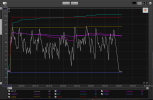My adventures in stereo
Senior Member
- Joined
- Feb 9, 2022
- Messages
- 340
- Likes
- 351
I have been putting together a Stereo system over the past few years
It is a book shelf sub system
I have been building up a collection of high dynamic range media & have often felt a need for more head room
Noticed that with a single NAD c298, aiming for roughly 85 db, as I pushed the volume higher, the sound was getting harsh
Had similar experiences with Audiophonics MPA 400 ET, hence I switched to NAD c298, with a marginal improvement in head room
The specifications provided by the manufacturer for my speakers recommended of 50- 150 Watts
Which my amplifiers exceeded
My SVS PB 2000x3 provided the bass grunt below 80 hz, hence the lack of head room was frustrating
Going through the NAD C298 review on ASR, Kal Rubinson was an early adopter & was using them in bridged mode with good results
This had got me interested in going that route
I was advised by many here against going this route, as an expensive misadventure with no audible benefits
Recently picked picked up a second c 298 & got it setup in bridged mode
I had a 3-6 db advantage in head room, depending on the recording
The transients & micro dynamics were much more discernible
I was enjoying the system much more
This got me thinking about how much head room you need, with high dynamic range source material
A few youtube videos were very useful, found through threads in ASR
1 Audioholics : What Specs Really matter in Audio amplifiers
This is a 3 part series, which provides a lot of insight in to amplifier ratings
2 Erin : How much power do you really need?
3 Harbeth How much Power do I Really need
4 Crown Power Calculator
Dynamic power requirements can be much higher than stated in the specs
The maximum quoted power for a speaker, is vaguely stated, objectively poorly calculated & defined
You need to pick a amplifier which has good basic characteristics like
- Flat Frequency response
- High SNR
- Have adequate power output based on your listening distance, speaker sensitivity, desired listening level and have enough head room to support the dynamic range of your listening material
This was the calculation, I got for my speakers

I hope this will be useful to others, planning a system
Present System
Revel M 126 Be
NAD c298 x2 Power amps ( the second power amp, is my latest acquisition)
MInidsp SHD
SVS PB 2000x3
Input is through
CD's
SACD
Vinyl
Tidal/ spotify

It is a book shelf sub system
I have been building up a collection of high dynamic range media & have often felt a need for more head room
Noticed that with a single NAD c298, aiming for roughly 85 db, as I pushed the volume higher, the sound was getting harsh
Had similar experiences with Audiophonics MPA 400 ET, hence I switched to NAD c298, with a marginal improvement in head room
The specifications provided by the manufacturer for my speakers recommended of 50- 150 Watts
Which my amplifiers exceeded
My SVS PB 2000x3 provided the bass grunt below 80 hz, hence the lack of head room was frustrating
Going through the NAD C298 review on ASR, Kal Rubinson was an early adopter & was using them in bridged mode with good results
This had got me interested in going that route
I was advised by many here against going this route, as an expensive misadventure with no audible benefits
Recently picked picked up a second c 298 & got it setup in bridged mode
I had a 3-6 db advantage in head room, depending on the recording
The transients & micro dynamics were much more discernible
I was enjoying the system much more
This got me thinking about how much head room you need, with high dynamic range source material
A few youtube videos were very useful, found through threads in ASR
1 Audioholics : What Specs Really matter in Audio amplifiers
This is a 3 part series, which provides a lot of insight in to amplifier ratings
2 Erin : How much power do you really need?
3 Harbeth How much Power do I Really need
4 Crown Power Calculator
Dynamic power requirements can be much higher than stated in the specs
The maximum quoted power for a speaker, is vaguely stated, objectively poorly calculated & defined
You need to pick a amplifier which has good basic characteristics like
- Flat Frequency response
- High SNR
- Have adequate power output based on your listening distance, speaker sensitivity, desired listening level and have enough head room to support the dynamic range of your listening material
This was the calculation, I got for my speakers
I hope this will be useful to others, planning a system
Present System
Revel M 126 Be
NAD c298 x2 Power amps ( the second power amp, is my latest acquisition)
MInidsp SHD
SVS PB 2000x3
Input is through
CD's
SACD
Vinyl
Tidal/ spotify
Last edited:





